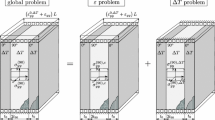Abstract
In many technological processes involving cutting or welding of thin plates there is local thermal heating or cooling at the tip of the cut by a thermal source. In this paper we analytically investigate the stress distribution induced by the point thermal source moving with a constant velocity across an infinite elastic plate. Stress intensity factor for the cut formed by the moving thermal source is calculated. It is shown that for welding the value of the stress intensity factor due to thermal stresses induced by the thermal source is equal to zero. For cutting in the case of positive values of the power of thermal source the stress intensity factors will be negative. This means that the thermal field induced by the point thermal heat source will tend to close the cut in the vicinity of the tip. The opposite situation occurs when the cut tip is cooled by the thermal source. As an example, the theory under development is shown when applied to some strength issues of thermal beam cutting of brittle materials.
Similar content being viewed by others
References
Bunting, K.A. and Cornfield, G. (1975). Toward a general theory of cutting: a relationship between the incident power density and the cut speed. Transactions of the ASME, Journal of Heat Transfer 116, 116–121.
Byshkov, Yu. and Marichev, O. (1983). Integrals and Series. Special Functions. Nauka Publisher, Moscow.
Freund, L.B. (1972). Crack propagation in an elastic solid subjected to general loading. I. Constant rate of extantion. Journal of Mechanical Physics and Solids l, 129–140.
Gonsalves, J.N. and Duley, W.W. (1972). Cutting thin metal sheets with the CW CO2 laser. Journal of Applied Physics 43, 4684–4687.
Karlsson, L. (1986). Thermal Stresses inWelding: in Thermal Stresses, Vol. 1, (edited by Hetnarski, R.B.), Elsevier Science Publishers, Amsterdam, 299–390.
Kotousov, A.G, Lu, G. and Pavlov, M. (1997). On uncontrolled fracture of thin plates during thermal beam cutting. International Journal of Fracture 88, L19–L23.
Kotousov, A. (1999). A thermo-mechanical effects associated with crack propagation. International Workshop on Fracture Mechanics and Advanced Engineering Materials, December 8- 10, Sydney University, Australia.
Li, K. and Sheng, P. (1995). Plane stress model for fracture of ceramics during laser cutting. International Journal of Machine Tools Manufacturing 35, 1493–1506.
Muskhelishvili, N.I. (1953). Some Basic Problems of the Mathematical Theory of Elasticity, Noordhoff, Groningen.
Nowacki, W. (1962). Thermoelasticity, Pergamon, Oxford.
Smith, R.N., Surprenant, R.P. and Kaminski, D.A. (1991). Fracture characteristics of an aluminum oxide ceramic during continuous wave carbon dioxide laser cutting. Proc. Laser Materials Processing Symp., San Jose, CA, USA.
Author information
Authors and Affiliations
Rights and permissions
About this article
Cite this article
Kotousov, A. Thermal stresses and fracture of thin plates during cutting and welding operations. International Journal of Fracture 103, 361–372 (2000). https://doi.org/10.1023/A:1007674623758
Issue Date:
DOI: https://doi.org/10.1023/A:1007674623758




